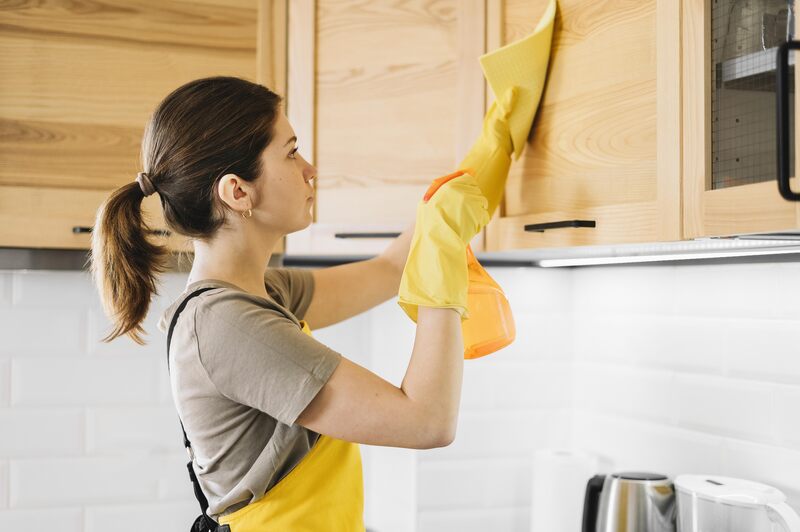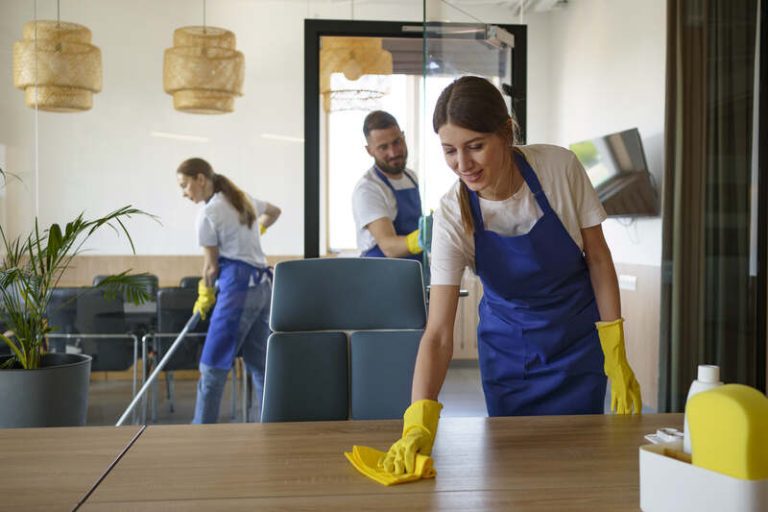Are your kitchen cabinets starting to look a little dirty and in need of cleaning? Should you be, then this how to clean kitchen cabinets guide is for you.
In this article, we will give you a step-by-step guide on how to clean kitchen cabinets through some simple do-it-yourself methods using household products such as vinegar, baking soda, and dish soap.
Follow along to the end for tips and how to clean kitchen cabinets to keep them clean and shiny.
How to Clean Kitchen Cabinets DIY?
DIY methods to clean kitchen cabinets can be incredibly effective and economical, often requiring just a few basic materials and a straightforward step-by-step approach to achieve spotless results. What follows is an explanation of how to clean kitchen cabinets in a simple way that you can try:
a. Using Vinegar and Water Solution
A vinegar and water solution is an excellent natural cleaner for kitchen cupboards, as vinegar effectively cuts through grease and grime while also disinfecting the surfaces.
To use this powerful cleaning mixture, simply mix equal parts of vinegar and water in a spray bottle.
Next, lightly mist the mixture onto the cupboard surfaces, ensuring the entire area is covered.
Then, take a clean microfibre cloth and gently wipe down the cupboards, focusing on areas with visible dirt or grease buildup.
The acidity of the vinegar not only dissolves stubborn stains but also acts as a natural disinfectant, leaving your kitchen cupboards sparkling clean and germ-free.
b. Using Baking Soda and Water Paste
For tackling tough messes on kitchen cupboards, a paste made from bicarbonate of soda and water can be particularly effective, as bicarbonate of soda’s mild abrasiveness helps to lift stubborn stains without damaging surfaces.
To create this cleaning solution, mix bicarbonate of soda and water in a small bowl until you get a thick paste-like consistency. Apply the paste onto a damp cloth or sponge and gently scrub the affected areas on your kitchen cupboards. The bicarbonate of soda acts as a gentle abrasive, breaking down grease and grime effectively. After scrubbing, wipe off the paste residue with a clean, damp cloth, revealing clean and refreshed surfaces that are free from tough messes.
c. Using Dish Soap and Warm Water
Washing-up liquid mixed with warm water is a versatile and gentle cleaning solution for kitchen cupboards, capable of cutting through grease and grime while being safe for a variety of surfaces.
To effectively clean your kitchen cupboards using this solution, start by mixing a few drops of washing-up liquid with warm water in a bucket or spray bottle. Use a soft cloth or sponge to dip into the soapy mixture, ensuring it is not dripping wet.
Begin wiping down the cupboards, focusing on areas with built-up grime or grease. Wipe in gentle circular motions to lift the dirt without damaging the surface. For stubborn spots, you can let the solution sit for a few minutes before gently scrubbing with a soft brush.
How To Clean Kitchen Cabinets in Different Types?
Cleaning different types of kitchen cabinets requires specific techniques and products to ensure that each material, whether wood, laminate, or painted, is properly maintained and protected from damage. The following is an explanation of how to clean kitchen cabinets in a variety of different types:
a. Wooden Cabinets
To clean wooden cabinets, it’s best to use a mild soap solution and a soft cloth, ensuring the surfaces are thoroughly dried afterwards to prevent water damage.
Begin by preparing your cleaning solution with a gentle soap or dish detergent diluted in warm water. Dip your soft cloth into the solution and wring out any excess water. Gently wipe down the wooden surfaces, being careful not to oversaturate them. Pay special attention to any areas with built-up grime or grease.
Once you have cleaned the cabinets, take a clean, dry cloth and carefully dry off all surfaces. This step is crucial as excess moisture can lead to warping or discolouration of the wood. Ensure that no water is left standing on or between the crevices of the cabinets.
b. Laminate Cabinets
Laminated cupboards can be effectively cleaned with a mild cleaner, starting from the top and working your way down to prevent smudging and ensure an even clean.
The top-down approach is crucial as it helps avoid the spread of dirt and grime to areas that have already been cleaned. When selecting a mild cleaner, opt for gentle soaps or vinegar solutions to protect the laminated surface.
Using abrasive cleaners or rough materials can harm the laminated finish, so it’s crucial to stick to soft cloths or sponges. Regularly dusting the cupboards can also help in maintaining their shine and cleanliness.
c. Painted Cabinets
When cleaning painted cabinets, it’s essential to use a non-abrasive cleaner to avoid damaging the paint, followed by a thorough wipe-down to remove any residue.
Start by mixing a gentle, non-abrasive cleaner with warm water in a spray bottle. Avoid harsh chemicals that can strip the paint or cause discolouration. Spray the solution onto a soft cloth or sponge, rather than directly onto the cabinets, to control the amount of moisture. Begin wiping down the cabinets, paying special attention to any spots or build-up. Wipe in gentle, circular motions to lift dirt without scratching the surface. Finish by using a clean, damp cloth to remove any remaining cleaner residue, ensuring the cabinets are left sparkling clean.
Alternative Methods to Clean Kitchen Cabinets
Plus traditional cleaning methods, there are several alternative approaches to cleaning kitchen cabinets, including the use of steam cleaners and hiring professional cleaning services for a thorough and hassle-free experience. The next section explains how to clean kitchen cabinets using alternative traditional methods that you can try:
a. Using Steam Cleaner
Using a steam cleaner can be an effective way to tackle grease and sanitise kitchen cabinets, as the high-temperature steam breaks down grime and kills bacteria without the need for harsh chemicals.
When using a steam cleaner on kitchen cabinets, it’s important to start by removing any surface dirt or debris with a gentle cleaning solution or cloth. Once the cabinets are prepped, simply fill the steam cleaner with water and wait for it to heat up. The hot steam can then be directed onto the cabinet surfaces, loosening the tough grease and grime that can accumulate over time.
One of the key benefits of using a steam cleaner is its ability to effectively dissolve grease without leaving behind any residue. This not only leaves your cabinets looking squeaky clean but also helps to maintain their finish in the long run. The high temperature of the steam helps to sanitise the surfaces, making them safe for food preparation and handling.
b. Hiring Professional Cleaning Services
Hiring professional cleaning services, such as those offered by Pure Freedom, can ensure a thorough cleaning of your kitchen cupboards, addressing even the most stubborn dirt and leaving your kitchen looking immaculate.
One of the main benefits of entrusting professionals to clean your kitchen cupboards is their expertise in handling a range of materials and finishes, which guarantees a comprehensive and efficient cleaning procedure.
These specialists are equipped with specialised tools and cleaning solutions that are specifically formulated to tackle stubborn stains and grime, delivering a standard of cleanliness that is difficult to achieve with standard household cleaning products.
Professional cleaning services can save you time and effort, enabling you to unwind and appreciate a freshly cleaned kitchen without needing to concern yourself with the detailed cleaning process.
Those are the complete guidelines on how to clean kitchen cabinets of various types, including some alternative traditional methods that you can try and follow. However, for a thorough and professional clean, entrusting the task to experts is highly recommended.
TEKA Cleaning offers top-notch residential cleaning and commercial cleaning services tailored to your needs. Our experienced team uses advanced techniques and eco-friendly products to ensure your kitchen cabinets are impeccably clean, free from grease, grime, and bacteria.
Ensure the longevity and hygiene of your kitchen cabinets with our specialised services. Book now or call us on 01233 751 544 to schedule your professional cleaning service with TEKA Cleaning. Let us handle the hard work, so you can enjoy a spotless and healthy kitchen environment.
Read also:










